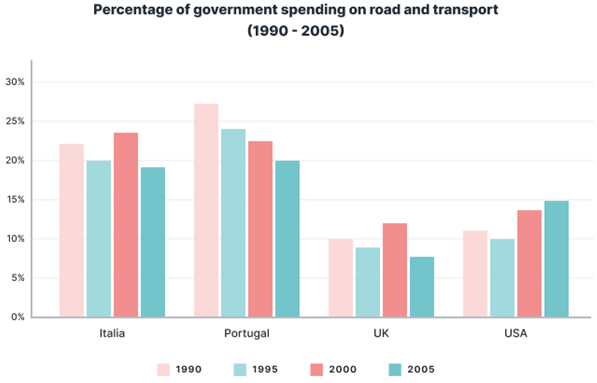5+ The charts below show the performance of spending on roads and transport in four countries
The charts below show the performance of spending on roads and transport in four countries from 1990 to 2005. Summarise the information by selecting and reporting the main features, and make comparisons where relevant. Write at least 150 words hay nhất giúp bạn có thêm tài liệu tham khảo để viết bài luận bằng Tiếng Anh hay hơn.
- The charts below show the performance of spending on roads and transport in four countries (mẫu 1)
- The charts below show the performance of spending on roads and transport in four countries (mẫu 2)
- The charts below show the performance of spending on roads and transport in four countries (mẫu 3)
- The charts below show the performance of spending on roads and transport in four countries (mẫu 4)
- The charts below show the performance of spending on roads and transport in four countries (mẫu 5)
- The charts below show the performance of spending on roads and transport in four countries (mẫu 6)
- The charts below show the performance of spending on roads and transport in four countries (mẫu 7)
- The charts below show the performance of spending on roads and transport in four countries (mẫu 8)
- The charts below show the performance of spending on roads and transport in four countries (mẫu 9)
5+ The charts below show the performance of spending on roads and transport in four countries
Đề bài: The charts below show the performance of spending on roads and transport in four countries from 1990 to 2005. Summarise the information by selecting and reporting the main features, and make comparisons where relevant. Write at least 150 words
The charts below show the performance of spending on roads and transport in four countries - mẫu 1
The bar chart illustrates how much the governments in 4 different countries spent on roads and transport in the years 1990, 1995, 2000 and 2005.
Overall, it is apparent that Portugal has the highest governmental spending on road and transport while the UK possesses the lowest statistics among the 4 countries.
Specifically, Portugal’s government allocated more than a quarter of the total spending on transportation in 1990, which was about 5% percent higher than the second-highest spender - Italy, with 22 percent. Meanwhile the UK and the USA’s expenditures were significantly lower at 10 and 11 percent respectively, which were 2.5 times lower than that of Portugal.
Regarding the changes over the years, the figures of Portugal declined steadily over the 15-year period to exactly 20 percent in 2005. In comparison, the corresponding figures from Italy and the UK also displayed a general downward trend throughout the studied period with the exception of a short increase in 2000. In contrast, the expenditure figures of the USA demonstrated an upward trend, rising to 15 percent in 2005, despite dropping a minimal 1% in 1995.
The charts below show the performance of spending on roads and transport in four countries - mẫu 2
The provided bar chart delineates the changes in government expenditure on roads and transport across several nations from 1990 to 2005.
Throughout this period, there was a consistent downward trend in state investment in roads and transport in Portugal, whereas the United States witnessed an increase. The remaining two nations demonstrated varying patterns in government spending within this sector. Portugal consistently upheld its status of the highest spender among the countries scrutinized.
In mainland Europe, Portugal initially allotted approximately 27% of its national budget to roads and transport in 1990, a substantially larger proportion compared to other nations. However, this percentage experienced a gradual decline, reaching 24% by 1995 and further descending to slightly above 20% by the conclusion of the period. Conversely, the USA exhibited a different trajectory, initially undergoing a minor decrease in the first five years, but ultimately directing a higher proportion of public spending towards road and transport, culminating at 15%.
Italy portrayed a more fluctuating pattern in spending, diminishing from 22% to nearly 20% in 1995, rebounding to 23% in 2000, and then regressing to approximately 19% by 2005. The UK mirrored similar trends, initially allocating slightly over 10% of its total expenditure towards roads and transport, witnessing a minor reduction in 1995, an increase to 12% in 2000, but subsequently decreased spending to about 8% by 2005, maintaining the lowest spending among the listed nations.
The charts below show the performance of spending on roads and transport in four countries - mẫu 3
The given bar chart shows the proportion of government expenditure on road and transport in four countries (Italy, Portugal, UK, USA) every five years between 1990 and 2005.
Overall, it can be seen that governments in mainland Europe spent far more money on roads and transport than those in the UK and USA. It is also clear that the UK spent the least amount of money on roads and transport in all measured years.
In 1990, Portugal spent the most amount of money on roads and transport at approximately 27%, followed by Italy at about 22%, while the USA and UK both spent only around 10% of their government budget. In 1995, however, all countries reduced their road and transport spending by between 1-3%.
By 2000 while Portugal continued to reduce its road and transport spending down to around 22%, Italy had increased its spending to approximately 23%, overtaking Portugal as the leading spender on transport infrastructure in 2000. The UK and USA both had increased spending in 2000 by about 3%. In 2005, all countries except USA further reduced their spending with Portugal, Italy, UK and the USA at 20%, 19%, 8% and 15% respectively.
The charts below show the performance of spending on roads and transport in four countries - mẫu 4
The bar chart illustrates the proportion of expenditure by governments of Italy, Portugal, the UK and the USA on road and transport. The study compared the figures recorded between 1990 and 2005 with 5-year intervals.
On the whole, the proportion of government spending on road and transport generally declined in each country surveyed but the USA. It is also noticeable that the shares of money spent for this purpose by Italy and Portugal were significantly higher throughout the span than those of the other two countries.
The USA, in 1990, spent approximately 12% of its total expense on road and transport, which was 2% higher than the UK figure in the same year. Despite falling slightly by around 2% in 1995, the USA’s spending had risen noticeably to 15% by the final year.
Interestingly, the European countries in the research all followed a downward trend. Portugal, being the biggest spender in 1990 and 1995, decreased the proportion of the funds it channeled from around 27% to a fifth over the period. Similarly, Italy and the UK’s proportional investment in road and transport experienced a drop during the time frame from about 23% to just under a fifth and from a tenth to about 7%, respectively, though each showed a rise in expenditure in 2000.
The charts below show the performance of spending on roads and transport in four countries - mẫu 5
The bar graph illustrates the proportion of governmental expenditure on road and transportation infrastructure across four nations - Italy, Portugal, the UK, and the USA - from 1990 to 2005.
Overall, Portugal emerges as a consistent frontrunner in the allocation of budgetary resources to transport infrastructure, leading in all years except 2000. In contrast, Italy and the UK experienced significant volatility in their spending patterns, ultimately trending downwards, while the USA demonstrated a rising commitment to transport infrastructure, particularly in the latter half of the observed period.
In the initial year of 1990, the disparities in spending were stark: Portugal allocated nearly 27%, Italy about 22%, and the UK only 10% of their respective national budgets to this sector. Over the ensuing decade and a half, Portugal’s investment displayed a gradual decline, settling at around 20% by 2005, indicating a notable reduction from its initial high.
During the mid-1990s, investment levels in Italy, the UK, and the USA dipped slightly, only to surge by approximately 30% in the next five years. By the end of the period in 2005, except for the USA, each country recorded a decrease in the percentage of their budget dedicated to road and transportation. The USA’s data distinctly reflects an increasing trajectory, prioritizing transportation infrastructure towards the close of the period reviewed.
The charts below show the performance of spending on roads and transport in four countries - mẫu 6
The presented bar chart delineates the percentage of governmental expenditure on road and transport infrastructure across four countries - Italy, Portugal, the United Kingdom, and the United States - from 1990 to 2005.
Observing the data, Portugal consistently allocated the highest percentage of its budget to road and transport, except in 2000. Italy and the UK showed considerable fluctuations in their allocations, with a general downward trend, while the US displayed a progressive increase in spending in this sector towards the latter part of the period.
Initially, in 1990, the allocations were notably diverse with Portugal investing approximately 27%, Italy around 22%, and the UK a mere 10% of their national budgets in this sector. Portugal's investment saw a declining pattern, decreasing to about 20% by 2005, illustrating a significant reduction over the 15 years.
Conversely, after a decline in the mid-1990s, investments in road and transport by Italy, the UK, and the USA saw a rise of approximately 30% in the subsequent five years. By 2005, however, apart from the USA, all countries experienced a reduction in the portion of their budgets dedicated to this sector. The data from the US indicates a clear prioritization of transport infrastructure in the final years of the survey period.
The charts below show the performance of spending on roads and transport in four countries - mẫu 7
The bar graph shows the proportion of national funds spent by the four distinct countries - namely, Italy, Portugal, the United Kingdom, and the United States - on roads and transportation between 1990 and 2005.
With the exception of 2000, Portugal registered the highest spending on road and transportation sector throughout the 15-year period. Another interesting point is that, whereas Italy and the UK had significant oscillations and subsequently a decline in their road and transport spending, USA saw an increased spending in this sector during the final five years.
In 1990, Portugal, Italia and the UK, respectively, spent about 27, 22, and 10 percent of their national budget for the sake of road and transportation. Portugal's spending in this area dropped by almost 15 percent per five-years throughout this period and, in 2005, it made up barely 20% of the whole national budget, down from almost 27% in the first year, 1990.
The investment on transportation infrastructure in the other three nations, Italy, the UK, and the USA, decreased somewhat in 1995 before increasing by roughly 30% during the next five years. With the exception of the United States, all three of the other nations had a decline in their national proportion of expenditure on road and transportation in 2005.
The charts below show the performance of spending on roads and transport in four countries - mẫu 8
The bar chart tracks the changes in the proportion of government outlay on road and transport in four different nations between 1990 and 2005. Overall, except for the USA, a downward trend was registered in the expenditure on road and transport in almost all surveyed countries. Furthermore, Italy and Portugal distributed the most financial resources in this sector throughout the period shown.
Regarding the two leading nations, about 27% of Portuguese government’s budget was allocated to road and transport in 1990, far surpassing the percentage of the Italian one by approximately 5%. During the next decade, however, a notable increase to nearly 24% was witnessed in the figure for Italy, allowing it to overtake Portugal’s first rank in 2000. By 2005, both countries underwent dramatic declines in their spending on this department, with data recorded only under the 20% threshold each.
Turning to the remaining countries, in 1990, road and transport occupied just around one tenth of government expenditure in the UK and USA, which both experienced substantial growths to above 13% over the following 10 years. Nonetheless, at the end of the time scale, the figure for America continued to surge to 15%, roughly double that for the UK, where merely less than 8% of its budget was allotted to road and transport.
The charts below show the performance of spending on roads and transport in four countries - mẫu 9
The bar graph illustrates the distribution of government spending on roadways and transportation infrastructure in four different nations between 1990 and 2005, at five-yearly intervals. Overall, the spending of America increased over the given period, whereas other countries decreased. Additionally, the highest investment was seen in Portugal except for the third year when Italian authorities spent a larger share.
Portugal and Italy were the major investors in the traffic system. Portugal ranked first at nearly 27% at the start, after which their expenditure fell consistently to precisely 20% by 2005. Similarly, the figure for Italy dropped from approximately 22% in 1990 to 20% in 1995. After reaching a peak of roughly 23% in 2000, it plunged to a low of just under one-fifth by the end.
Concerning the other countries which spent significantly less, the British authorities allotted the lowest rate of 10% in 1990 and later it further decreased minimally by about 1% in the following five years. Despite recovering to a high of around 12% after five years, it declined by about 4% in the end. In contrast, the American government allocated approximately 11% of their state budget in 1990, followed by a slight drop to 10% five years later before increasing moderately by 5% in the final year.
Xem thêm các bài luận Tiếng Anh hay khác:
Đã có app VietJack trên điện thoại, giải bài tập SGK, SBT Soạn văn, Văn mẫu, Thi online, Bài giảng....miễn phí. Tải ngay ứng dụng trên Android và iOS.
Theo dõi chúng tôi miễn phí trên mạng xã hội facebook và youtube:Nếu thấy hay, hãy động viên và chia sẻ nhé! Các bình luận không phù hợp với nội quy bình luận trang web sẽ bị cấm bình luận vĩnh viễn.
- Đề thi lớp 1 (các môn học)
- Đề thi lớp 2 (các môn học)
- Đề thi lớp 3 (các môn học)
- Đề thi lớp 4 (các môn học)
- Đề thi lớp 5 (các môn học)
- Đề thi lớp 6 (các môn học)
- Đề thi lớp 7 (các môn học)
- Đề thi lớp 8 (các môn học)
- Đề thi lớp 9 (các môn học)
- Đề thi lớp 10 (các môn học)
- Đề thi lớp 11 (các môn học)
- Đề thi lớp 12 (các môn học)
- Giáo án lớp 1 (các môn học)
- Giáo án lớp 2 (các môn học)
- Giáo án lớp 3 (các môn học)
- Giáo án lớp 4 (các môn học)
- Giáo án lớp 5 (các môn học)
- Giáo án lớp 6 (các môn học)
- Giáo án lớp 7 (các môn học)
- Giáo án lớp 8 (các môn học)
- Giáo án lớp 9 (các môn học)
- Giáo án lớp 10 (các môn học)
- Giáo án lớp 11 (các môn học)
- Giáo án lớp 12 (các môn học)






 Giải bài tập SGK & SBT
Giải bài tập SGK & SBT
 Tài liệu giáo viên
Tài liệu giáo viên
 Sách
Sách
 Khóa học
Khóa học
 Thi online
Thi online
 Hỏi đáp
Hỏi đáp

